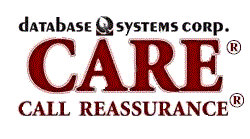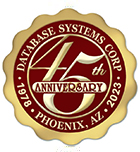|
|



Related Articles
Medication Reminder Services
 Database Systems Corp. (DSC) has been in the telecommunications business since 1978 and is a leading provider of computer telephony software and phone technology including telephone reassurance phone systems that contact homebound residents to ensure their well-being.
Database Systems Corp. (DSC) has been in the telecommunications business since 1978 and is a leading provider of computer telephony software and phone technology including telephone reassurance phone systems that contact homebound residents to ensure their well-being.
Employing our advanced calling technology, DSC can send pill reminders such as medication reminders for seniors and homebound patients in just minutes. A recorded message can be delivered to either answering machines or to individuals reminding subscribers to take their prescription medication.
Medication reminders can be customized for each senior including special instructions. Custom information for each patient (such as name, medication type, prescription dosage, number of times per day, etc.) can be included in these medication reminder messages.
The following article is useful when considering the importance of taking your pills as prescribed.
Contact DSC to learn more about our medication reminder services and systems.
Understanding Prescription Drug Misuse In Older Adults
Source: Science Blog, Eugene Jacquescoley
Current as of July, 2008
Prescription medications play a vital role in patient care, but the improper utilization of prescription drugs can be the cause of a variety of problems.
As baby boomers assume their respective roles in the 21st century, the National Institute on Drug Abuse (NIDA) indicated that the incidence of adverse events related to drug reactions in older patients is two-three times higher than young adults. It is also important to mention that the slow metabolism rates and blood flow may also attribute to the exacerbation of these types of adverse events in older adults.
Health care professionals must be aware of the components that drive this unique problem in this complex cohort. The marriage of geriatric medicine/gerontology and drug physiology is critical when determining if an adverse event has taken place; and how treat and manage the patient thereafter. Furthermore, due to the complexity of some drug regimens, compliance may also be an area of concern for this cohort. There is also a growing body of evidence that suggests there are gender differences while examining drug misuse in the elderly. According to (Simoni-Wastila, 2003) nearly 7.2 million older patients were medically exposed to prescription drugs with addictive potential. Among the 7.2 million, there is a suspicion that half of this population (which represents women) may require different treatment approaches compared to men. Of course, this frame of dialogue is still in infancy, but warrant attention.
Prescription drug abuse and/ or misuse among the elderly are a unique and dangerous trend that warrants national attention. According to the US Bureau of Census, by 2010, there will be over 39 million Americans above the age of 65. By 2020, it is expected to increase to 53 million Americans (NIDA). Drug misuse may refer to the use of medications that result in social, psychological, and/or physical harm. It encompasses not taking necessary medications to becoming dependent upon psychoactive drugs (Ignatoff, 2005).
There are several types of drug misuse in this cohort. Overdose, underdose, use of prescriptions for other than prescribed, and drug combinations. Moroever, other factors should be considered. Such as difficulty reading, cognitive deficits, costs of medications, and the complexity of drug treatment may lead to the types of drug misuse in the elderly (Patterson, 2003).
A number of quantitative factors should be considered:
- 1. Estimated numbers of people over 65 y.o. with psychiatric disorders has steadily climbed from 4 million in 1970 to 7million in 2010 (NIMH).
- 2. According to the NIMH, approximately 1,300,000 of the US general population or 4% reported problems prescription drug use.
- 3. There is a correlation with increased prescription drug cost and misuse among those above the 65 y/o (Patterson, 2004).
- 4. The number of drug-related episodes with individuals above the age of 65 has increase from 200,000 in 1995 to 325,000 in 2002 (NIMH).
- 5. The number of deaths related to medication errors in the US climbed from 3000 in 1983 to 8000 in 1993 (Phillipe et al, 1998).
- 6. Prescription drug related problems may cost an estimated $75 billon yearly (Ignatoff, 2005)
The most successful prevention strategy is effective communication between the healthcare provider and the patient and/or caregiver. Due to complicated treatment regimens and potential side effects; it is important that health care providers discuss these issues with the patient. It also important to note, that the patient be forthcoming with their over-the-counter medications, herbs and vitamins; while taking prescription drugs. It has been documented that older patients often self diagnose and misunderstand the label warnings; and the pharmacokinetics associated with the administration of drugs and over-the-counter medications. Pharmacokinetics refers to absorption, distribution, metabolism and excretion of drugs. It is my opinion that social marketing campaigns that specifically address this issue would raise awareness about drug misuse and associated costs in the elderly.
Nursing homes and other skilled nursing facilities should adopt alternate communication strategies with their residents, faculty, and regulating bodies (as appropriate). Medical directors of nursing homes should also become more proactive in managing this process of communication with charge nurses and other caregivers. The challenge of many nursing homes with regards to full-time equivalents (FTE) to patient ratio has been at the forefront of the nursing home community. Having effective communication polices and strategies tailor made to their respective patient population, may help prevent or reduce adverse events from occurring.
References
Patterson, L. (2003). Prescription Drug Abuse and Misuse in the Elderly. National Institute of Mental Health. Center Grants P30 MH 49693, MH45131. Retrieved from www.nihm.gov on July 28, 2008.
Ignatoff, A. (2005). Preventing Drug Misuse in Seniors. Retrieved from http://seniorjournal.com/NEWS/Health/5-07-13DrugMisuse.htm on July 15, 2008.
National Institute of Drug Abuse. [Online]. Elder Drug Misuse (Key search field). Retrieved from http://search2.google.cit.nih.gov/search?q=ELDER+DRUG+MISUSE&site=NIDA&c... on June 20, 2008.
Simoni-Wastila, L. (2003). Prescription Drug Nonmedical Use and Abuse in Older Women. National Institute of Drug Abuse. Retrieved from http://search2.google.cit.nih.gov/search?q=ELDER+DRUG+MISUSE&site=NIDA&c... on June 20, 2008.
Additional Medication Reminder Articles
The following are other articles relating to medication reminders and prescription refill services:
Register Online For Reminder Service
 DSC provides an online signup for non-profit and commercial organizations wishing to use our telephone reminder calling service. Use this form to obtain a quotation and pricing information about our services with no obligation until you fax or mail your signed agreement.
DSC provides an online signup for non-profit and commercial organizations wishing to use our telephone reminder calling service. Use this form to obtain a quotation and pricing information about our services with no obligation until you fax or mail your signed agreement.
For non-profit organizations, our setup fees are waived and the basic monthly fees are reduced if you use this convenient method of registration.
Signup online and SAVE! using convenient Online Registration forms.
Contact Us Today
Contact DSC to learn more about our call reminder technology products, software and services.
|
|




 Database Systems Corp. (DSC) has been in the telecommunications business since 1978 and is a leading provider of computer telephony software and phone technology including telephone reassurance phone systems that contact homebound residents to ensure their well-being.
Database Systems Corp. (DSC) has been in the telecommunications business since 1978 and is a leading provider of computer telephony software and phone technology including telephone reassurance phone systems that contact homebound residents to ensure their well-being.
 DSC provides an online signup for non-profit and commercial organizations wishing to use our telephone reminder calling service. Use this form to obtain a quotation and pricing information about our services with no obligation until you fax or mail your signed agreement.
DSC provides an online signup for non-profit and commercial organizations wishing to use our telephone reminder calling service. Use this form to obtain a quotation and pricing information about our services with no obligation until you fax or mail your signed agreement.